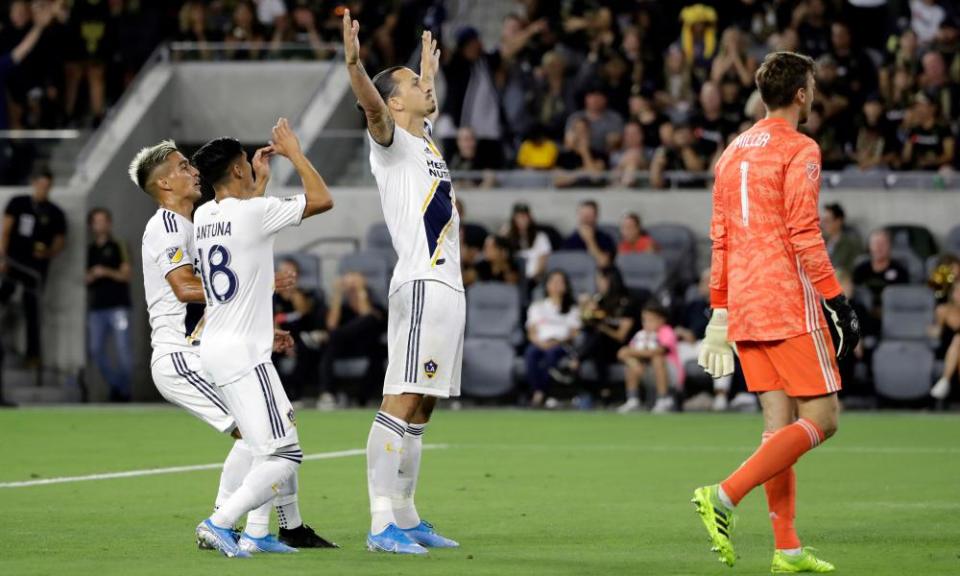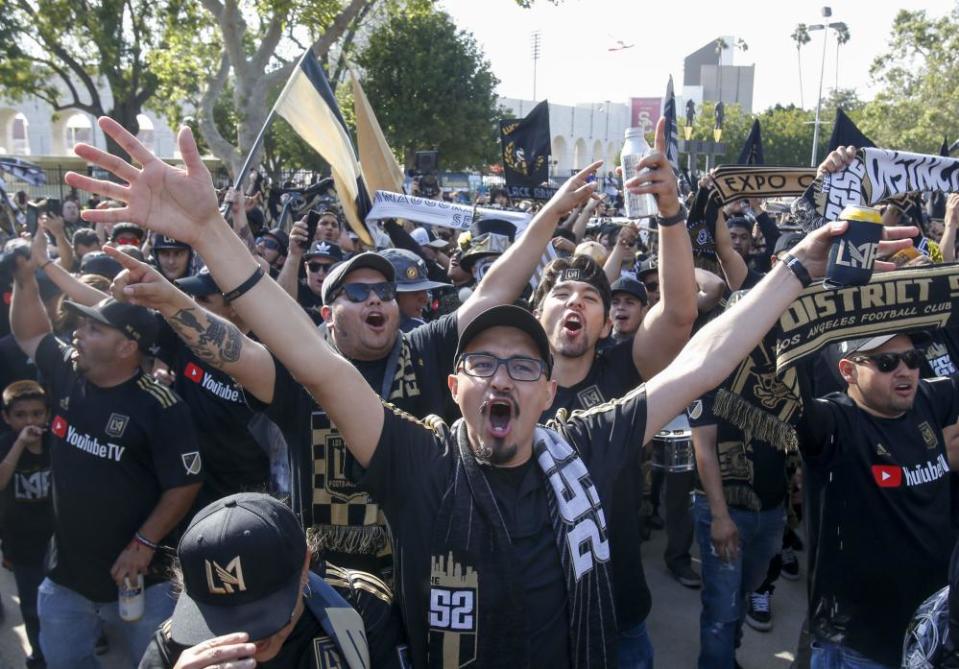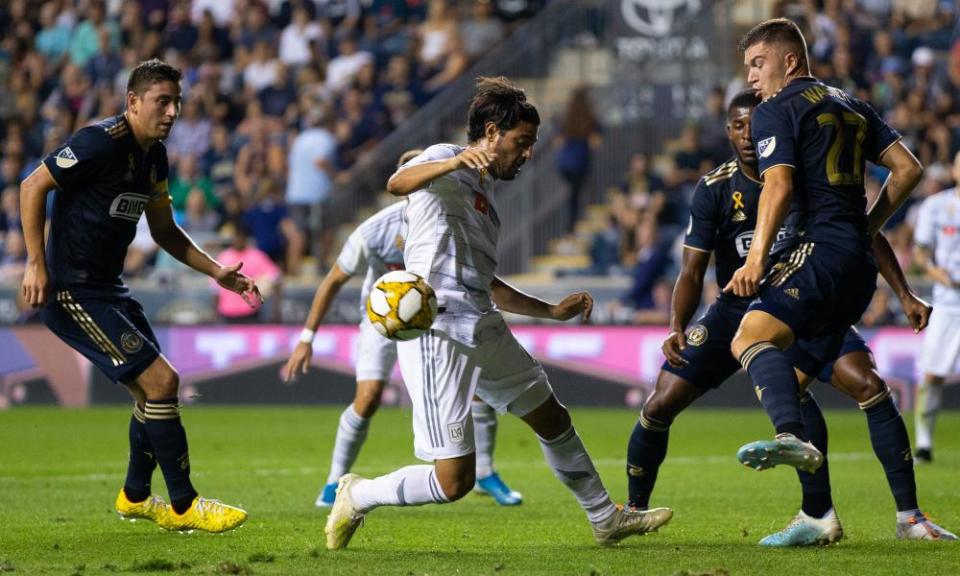El Tráfico: how LAFC and Galaxy built a rivalry from scratch

Fans of two soccer clubs separated by 12 miles of freeway forged an intense rivalry before one of them ever took the field. In May 2017 – three months before Los Angeles Football Club signed even one player – a mural in the new club’s colors appeared in downtown Los Angeles. It depicted men and women of various ages, ethnicities and professions dancing, playing and celebrating soccer while flanking the new club’s emblem: the initials “LA” in an Art Deco motif, with a wing serving as the “A’s” crossbar.
One week later, vandals painted a “GA” in capitals to the left of the crest and an “XY” in capitals to the right, causing the mural to read “GALAXY,” in a reference to the club that had ruled the city’s soccer scene for years, LA Galaxy.
When the teams meet on Thursday night in the second round of the MLS Cup playoffs, the rivalry known as El Tráfico will reach a singular level 15 years after the league tried – and failed – to foster a similar rivalry in Los Angeles.
In 2004, MLS granted an expansion franchise to Jorge Vergara, who owned one of Mexico’s most popular teams: CD Guadalajara, also known as Chivas. The new club would be known as Chivas USA, with a uniform and crest imitating their Mexican parent, and would begin play in 2005.
Related: NYC FC are one of MLS's best teams – and they're still playing in baseball stadiums
Vergara and the league saw a mutual benefit. Vergara wanted Chivas USA to expand Guadalajara’s brand among the nine million Latinos – mostly of Mexican descent – living in the five counties surrounding Los Angeles. For MLS, Vergara’s investment not only represented an opportunity to cultivate Latino fans, it also provided fresh capital to a desperate league. At the time, only three parties owned MLS’s 10 clubs, and the league nearly went bankrupt before eliminating two teams in 2002.
Vergara focused on signing Latino players. Of Chivas USA’s 10 selections in the 2004 expansion draft, four of the first five were Mexican-Americans or Mexican nationals. Vergara also signed two former Guadalajara stars, midfielder Ramon Ramirez and goalkeeper Martin Zuniga, both past their prime.
After compiling the league’s worst record in its first season, Chivas USA hired Bob Bradley as their head coach – the same Bob Bradley who now guides LAFC. In Bradley’s lone season before becoming the United States’ national coach, Chivas USA earned the first of four consecutive playoff berths. In 2007, they finished top of the Western Conference. In the 2009 playoffs, the Galaxy beat Chivas USA on the way to the MLS Cup final.
But two factors worked against Chivas USA. First, the team played and trained at the Galaxy’s suburban stadium in Carson while staff shared office space. Second, by trying to appeal to CD Guadalajara’s fans, Vergara risked alienating Mexicans and Mexican-Americans who rooted for other clubs, not to mention the myriad other Latino communities in Los Angeles.

“Chivas USA misjudged, or at least misread, its intended fan base,” said Keegan Pierce, who was the club’s broadcasting and communications director for five years. “Fans shouldn’t be forced into picking one set of interests. They certainly shouldn’t be forced into a single vision of what it means to be Mexican or, in this case, to be a Mexican-American fan of Major League Soccer.”
Things rapidly deteriorated after Vergara and his wife bought out their partners in 2012 to assume sole ownership. In 2013, Vergara eliminated office staff and refused to negotiate a broadcasting contract. He also demanded a renewed emphasis on a Mexican identity, to the point where two non-Latino academy coaches filed a discrimination suit.
That year, Chivas USA won just six of their 34 league games, and drew an average of 8,366 home fans, the lowest in MLS. Frustrated fans even hired a plane to tow a sign demanding Vergara’s ouster.
In 2014, MLS bought Vergara out for $70m and operated the club while trying to find a buyer. When that failed, MLS jettisoned Chivas USA after it attracted just 7,063 fans per game. The league announced Chivas USA’s demise a day after the club won their final ever match. Three days later, MLS granted another expansion franchise to a new ownership group representing Los Angeles.
That group – which includes Vincent Tan, who owns Cardiff City in England’s Championship – immediately dedicated itself to finding a new home and identity. In the process, it received support from Black Army 1850, founded in 2010 to support Chivas USA. Black Army 1850, named for the year California became a state, formed the basis for The 3252, a confederation of LAFC’s supporters. The confederation’s name refers to the number of places where supporters can stand in the north end of LAFC’s home, the Banc of California Stadium.

“There were obviously many sectors of the city that didn’t identify with the Galaxy,” said Eduard Cauich, sports editor for the Los Angeles Times’ Spanish-language edition. “There are many people in Los Angeles that haven’t been to a soccer game in Carson because of distance, and many other reasons. Since the David Beckham era, Galaxy started to focus more in Orange County, the South Bay and other parts of southern California.
“Many of the 3252 leaders came from Chivas USA and will never sympathize with the Galaxy, even during the time that they had no team. These people already had experience recruiting and with more resources, became bigger and stronger.”
The new owners mined that potential.
“LAFC since the beginning has felt more of a ‘downtown’ team, a team you have easy access to by public transportation,” Cauich said. “LAFC also did a fantastic job designing the identity of the team: a team that belongs in downtown Los Angeles, feels more Angelino, and with a ‘party’ atmosphere that feels more authentic to the atmosphere they have in their native countries. LAFC became more a ‘team of the people.’”
Then the Galaxy’s Zlatan Ibrahimović ignited the spark to the rivalry’s tinder.
AMAZING.#zLAtan#LAvLAFC https://t.co/xyk78K6xSr
— Major League Soccer (@MLS) March 31, 2018
In the teams’ first meeting ever last year, Ibrahimović made his MLS debut as a substitute. Visiting LAFC built a 3-0 lead in the first 48 minutes but the Galaxy narrowed the deficit to 3-2 by the time Ibrahimović entered in the 71st minute. Six minutes later, Ibrahimović tied the score with a dramatic 38-yard volley. Then in stoppage time, he scored a header to give his new club a 4-3 victory.
In five games against LAFC over two seasons, Ibrahimović amassed eight goals, including three in a 3-2 victory in July. Before that game, a reporter asked whether he was better than LAFC’s Carlos Vela, who set the league’s single-season scoring record this year. “By far, because if he’s in his prime. How old is he? 29,” Ibrahimović told ESPN. “And he’s playing in MLS and he’s in his prime. When I was 29, where was I? Big difference.”
For the record, when Ibrahimović was 29, he was playing for Milan on loan from Barcelona.
During the July game, Ibrahimović elbowed LAFC defender Mohamed El-Munir as both were leaping for an aerial ball; El-Munir would require surgery to repair a fracture between his right eye and cheekbone. Afterward, LAFC goalkeeping coach Zak Abdel confronted Ibrahimović on the field. Ibrahimović cursed at Abdel, forcing bystanders to separate them.
That confrontation contributes to a brief but intensely emotional rivalry – one that pits Ibrahimović against Vela, the Galaxy’s five MLS Cups against LAFC’s record-setting offense and Supporters’ Shield, and the older club’s unbeaten record against their neighbor.
“The drama of the games so far has obviously made the rivalry an instant hit, and the quest for eternal bragging rights is real on both sides,” MLSSoccer.com’s Alicia Rodriguez said. “It’s palpable.”
On Thursday, with both teams’ seasons on the line, that rivalry will only grow more intense.

